In-depth Look at Amazon’s “Transparent” with Cinematographer Jim Frohna
I wanted to take a moment to give a proper introduction to Jim Frohna and thank him for taking the time to write the following blog post and sit down with us for an interview. He shared his work and his insight on the vision and direction he had created for this incredible show, Transparent. Prior to working for Shane as his Assistant, I had the pleasure of working on my first feature film, which was Jim’s, Afternoon Delight (2013). While on set, I had the opportunity to sink my teeth into a strong foundation of filmmaking and watching a story come to life.
Jim pours his heart and soul into every ounce of his work, which is evident in every frame that he captures. He becomes one with the story, the actors, his camera, and his team. He is a dear friend of Shane and Lydia’s, and I am proud to have had the opportunity to learn from his vision and creative mind. The following interview that our Hurlbut Visuals team shot tells the story of Jim’s vision for his work on Transparent. Props to Krista Jee Baxter (On-site Producer, Hair & Makeup) and Alex Potter (Gaffer, B Camera) for their help on this project.
Transparent Series on Amazon Prime Video
If you haven’t seen Transparent yet, you should. No really, you should. It only took three days for me to fit in watching the whole season. I’m personally hooked on the show and it has opened my eyes to understanding the transgender community and realizing that the stereotypes in which we hear are so far from the truth. It’s incredible to see a show on television that is making an impact on our society and to see the creation on screen that Jill Soloway and Jim created. Words almost cannot describe what it is to see. They’re doing more than just making television; they’re changing our lives. The story just captures you and drives you toward the characters. It’s magical.
On Sunday, Transparent was awarded two Golden Globes – Best Television Series, Comedy or Musical and Best Performance by an actor in a tv series, Comedy or Musical: Jeffrey Tambor. The cast is incredible and Tambor captures your heart. Season 1 is complete, so you can binge watch away and wait for Season 2 to come later this year!
Jim Frohna on Transparent (Guest Blogger)
Transparent marks my first foray into the world of episodic TV and my second collaboration with director/writer Jill Soloway. We first worked together on the feature Afternoon Delight, after Jill had seen my commercial and documentary work. The way that I shoot, with naturalistic lighting and a good amount of handheld, fit what she envisioned for the movie.
In this way, the move into narrative was a smooth, natural progression and I was able to bring my strengths, honed on years of commercials, videos, and documentaries, to serve the story. In the case of Afternoon Delight, the goal was for the audience to feel an immediacy with the story and intimacy with the characters. Our efforts paid off, with the movie premiering in the Dramatic Competition at Sundance 2013, where Jill was awarded Best Director.
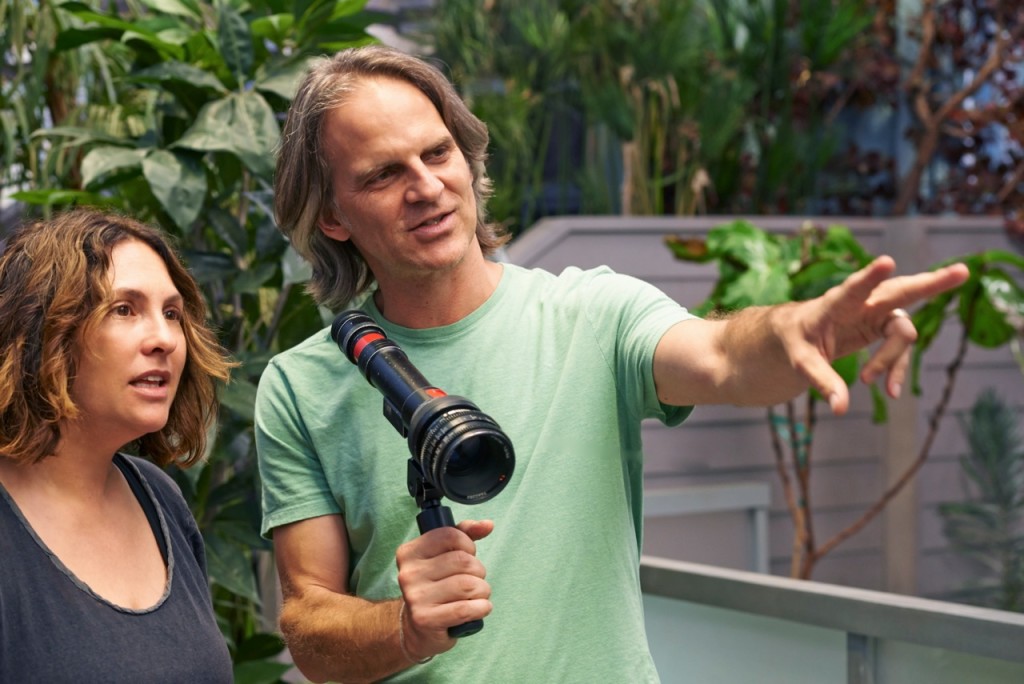
Director Jill Soloway (left), DP Jim Frohna (right) line up a shot in Season 1 of Transparent. Photo by Jill Greenburg
When Transparent came along, Jill expressed the desire to take our shooting style even further. This started in pre-production when Jill invited me to join her and the cast for a series of very intense rehearsals. These were not typical rehearsals where the actors run scenes or dialogue, but an exploration of the Pfefferman family dynamic, through music, movement, and feeling.
The Filmmaking Technique
We worked with a remarkable teacher named Joan Scheckel, whom I often refer to as a “filmmaking guru,” who runs workshops and filmmaking labs in Hollywood. Joan has a road map, dubbed The Technique, which steers all the players involved deep into the essence of the story and in our case, to collectively discover the burning core of the whole season of Transparent.
As a DP, to be present for these rehearsal sessions was a revelation. It gave me an intimacy and comfort with the cast and opened up a new level of trust and collaboration with Jill. We headed into production with a deep understanding of the subtext and guts of the family dynamic, which we could track through any given scene or episode from the first to the last.
The way into telling the family story was to be completely connected to the feeling of a scene or character. Jill and I decided that our approach would boil down to this: Give the actors the room and space to bring the story to life and the camera is there, both as witness and participant, to document the emotional journey.
Filming Transparent series
For starters, we rarely ever gave the actors marks to hit. They were free to utilize the space and follow their instincts, to try different things on each take. Many of my favorite moments and scenes came while I, as the A camera operator, had the camera on my shoulder, following the actors around the room, responding to what was unfolding.
This is when I felt the most connected to the actors, to the story, and the emotions. But what may be invigorating for me is an incredible challenge for the camera crew— there were many shoot days where everything felt caught on the fly.
Fortunately, B camera operator DJ Harder was familiar with our style, having been a key part of Afternoon Delight. Huge props must be given to my focus puller Shelly Gurzi and B Camera focus puller Nick Fischer. I would tell them that even if there’s an instant out of focus or they are catching up to the actor, those “mistakes” are in fact part of the language of giving the story its living, breathing, character.
Lighting further supported our goals, namely by keeping gear out of the room, while still maintaining a naturalistic look. We went with big sources such as outside windows (which is my preference, always) with a minimal amount of gear in the room. Not only did this provide the actors with freedom, but it also meant that the camera could look in nearly all directions at any time.
The Look of Transparent on Amazon Prime Video
On the pilot, we shot all locations. For the series, we were on stage 60% of the time, with the main house and other key locations duplicated as sets. Despite having three stages worth of sets at Paramount, I still wanted to shoot as if we were on location, which meant no fly-away walls or ceilings.
We strived to create a very natural look, so that viewers wouldn’t know when we were on stage versus a real location. It was a big challenge, but one that the lighting and grip crew, led by gaffer Jeremy Launais and key grip Joe Macaluso, met admirably.
“the house comes to represent both the future … and the past, as we see flashbacks of Mort leading a double life and the kids unaware that they are growing up in a house full of many secrets”
One set in particular, the Pfefferman family home, provided many creative challenges. The mid-century style house set was massive and had floor-to-ceiling windows in the main family room as well as a wraparound glass wall along most of the set. The house represents a great deal to the characters. It’s the house the kids all grew up in.
The Evolution of Lighting Throughout the Season
In the pilot, we learn that Jeffrey Tambor’s character Mort, the father to the three adult children, wants to sell the house as he prepares to shed his old identity and start living as a transgender woman named Maura.
Over the course of the season, the house comes to represent both the future — as eldest daughter Sarah, newly separated from her husband, moves in and attempts a fresh start– and the past, as we see flashbacks of Mort leading a double life and the kids unaware that they are growing up in a house full of many secrets.
Jeremy, Joe, and I wanted the light to reflect the different storylines of the past, present, and future. The first conversation we had was about how, even in a house with a huge amount of glass, the legacy of the house, with its many secrets (not just Dad’s) and all the hiding that went on in the family, no direct sun would ever enter the house. In my mind, the sun was diffused by a thick layer of that uniquely Los Angeles haze.
Lighting
This created a soft, ambient light that at times was quite murky and dim, especially as you moved away from the more public areas of the house and toward the bedrooms. In the second half of the season, new life and possibility enters the house as Sarah and her old college girlfriend Tammy reunite, move in and start remodeling. Things get a little brighter and a bit warmer, but in a fairly subtle way. In the flashbacks, there is a warmer look, but also a heaviness to the quality of the light.
The biggest shift occurs in the tenth and final episode of the season. Maura has, over the course of the season, come out to all the family members to varying degrees of acceptance and/or upset. Her need to be free and willingness to risk her family’s love is a deep and significant shift away from the years of hiding and secrets. I wanted us to reflect that dramatic change in the way we lit and filmed the house.
Despite the unfortunate circumstances that bring them all together, sunlight pours into the house. The bright sun, however, was not meant to equal happiness. The light is direct, even a bit harsh. It’s meant to be about exposure, shedding light where there used to be shadows. While I can’t say these ideas would consciously translate for viewers, it gave us opportunities to challenge ourselves to help tell the story with light.
Cameras and Lenses
When it came to choosing a camera that would serve our shooting style, both Jill and I responded to the Canon C500. We had used the Alexa on the pilot but had used the c500 as B cam for intimate scenes or sex scenes and I loved how those scenes looked most of all. When in prep for the season, we learned that Amazon was now requiring all their shows to shoot in 4K, so I organized a blind test of the Red Epic, the C500, and the Sony F55.
The C500, paired with older Zeiss Super Speeds, won by a long shot. The way the camera interprets colors reminds me of Fuji motion picture film. The image quality, especially when paired with older lenses, has a texture and character that feels filmic as well.
“I’d shoot an actor in a moment of reflection, unaware of the camera, and these moments ended up making their way into the episode”
During production, we had two cameras in studio mode and a third camera in a lean, stripped-down handheld mode, dubbed the “Intima-C Camera.” This is where the c500 really delivered. Its compact size, even when mounted with the 7Q recorder/monitor, allowed me freedom and nimbleness to manage scenes where we’d do back-to-back, incredibly long takes, sometimes up to 30 minutes each take.
The MōVI
The camera also had a great profile for the MōVI10, which I bought before shooting the series. We had the MōVI on hand the whole shoot and could quickly execute Steadicam-style shots and more. I also took advantage of the low profile of the camera to grab moments or cutaways after Jill had called cut. More than once, I’d shoot an actor in a moment of reflection, unaware of the camera, and these moments ended up making their way into the episode.
Camera Quality
The c500 also stood out for how it handled low light and the ability to shoot at high ISO settings. There were many night exteriors where I was shooting at a 2.0 at 2000ISO. We shot a few scenes at 2500 and we even shot one-night driving scene at 4000. It’s pretty wild to now have these digital tools that can see into shadows and often see more than the human eye.
With the c500, rather than the image falling apart or getting muddied up with digital noise, the image actually acquired a graininess and a quality that felt more like pushed film stock. It was exciting and fun to field test the camera, to see how it handled various situations during the shoot. Each time I came away more impressed with the c500.
Digital Workflow
As with any digital workflow, there are certain challenges, little gremlins that pop up to mess with you. We learned a lot very quickly—like how often the camera needs to cool down before the fans turn on for example.
We quickly embraced the wisdom of being able to record both externally and as a backup internally to a CF card, just in case. I had no time to do any on-set color and used just the standard Rec 709 as our setting. Using the “keep it real” approach, (which includes no filtering except NDs and Polarizers), I tend to light how I want things to look and typically don’t do a lot of tweaking with a DIT anyway.
Post-Production
When it came to post, the adjusting and color timing was in the capable, creative hands of Corrine Bogdanowicz at Light Iron. I first worked with Corinne on Afternoon Delight, so there was already history between us. Given the great job she did, we were very happy to be back at Light Iron with the series. They were one of the first post houses to embrace Canon as well as 4K file systems. So, we knew they would be more than able to handle the series.
At Light Iron, they care deeply and it shows. They managed to deliver the show with grace and professionalism within an insanely tight post schedule. We wrapped August 8th and the series premiered on September 26th, 2014 and the show looks great.
The Bottom Line
All in all, I’m very proud of the work we all did on Transparent and of all the accolades the show is getting. It was an amazing experience to be a part of this team and share the experience of seeing our work be recognized at the Golden Globes, I’m amazed and extremely proud to be apart of what we have created. I do know that the attention means that more and more people will hear about the show and “tune in” to Amazon Prime. I can’t wait for mid-May when we dive deep into Season 2.
If you have not seen Transparent yet, you can watch the Pilot episode for free on Amazon Prime. Your yearly membership to Amazon Prime will give you access to all of the episodes of Transparent, as well as many other programs, movies, and free two-day shipping on select items!




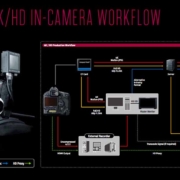
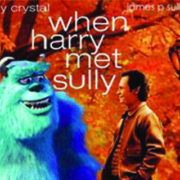
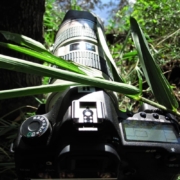
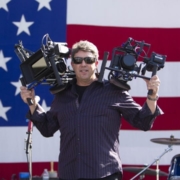

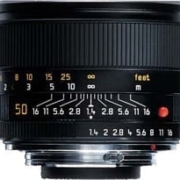


I LOVE this show, and LOVED this post. Some friends who work on the show say it’s the best experience on a set they’ve ever had. Had the pleasure to meet Jim (and Jill – actually) in LA after their LA film fest screening of “Afternoon Delight”. Wonderful guy, talented shooter; part of an inspired team of storytellers any filmmaker would be happy to be a part of. Thanks so much for making this and sharing with us, Shane!
Thank you so much Blaine. Jim is a great friend and our team had a great time interviewing him. This show is fantastic, he does a phenomenal job.
Learned a lot here. Although the more elaborate lighting techniques are fantastic, I love that quote “Light the room not the actors”! On a shoestring budget, for shooting a party scene in a living room with only 2 lights, using Shane’s lesson on top light along with this quote, we bounced the daylight balanced lights off the white ceiling in combination with the large window light. The actors and cameras could move around freely in the natural looking light. Sometimes simple works best!
That’s excellent Vance. Glad to hear that you were able to achieve a simple setup for your shoot!
This show is good, but it looks terrible. The frame rate is obviously high, making for very “digital” like motion. Way too videoish. Surprised at how badly it compresses too. Specifically looked up this article to see why it looks so bad, i guess its the c500s fault…